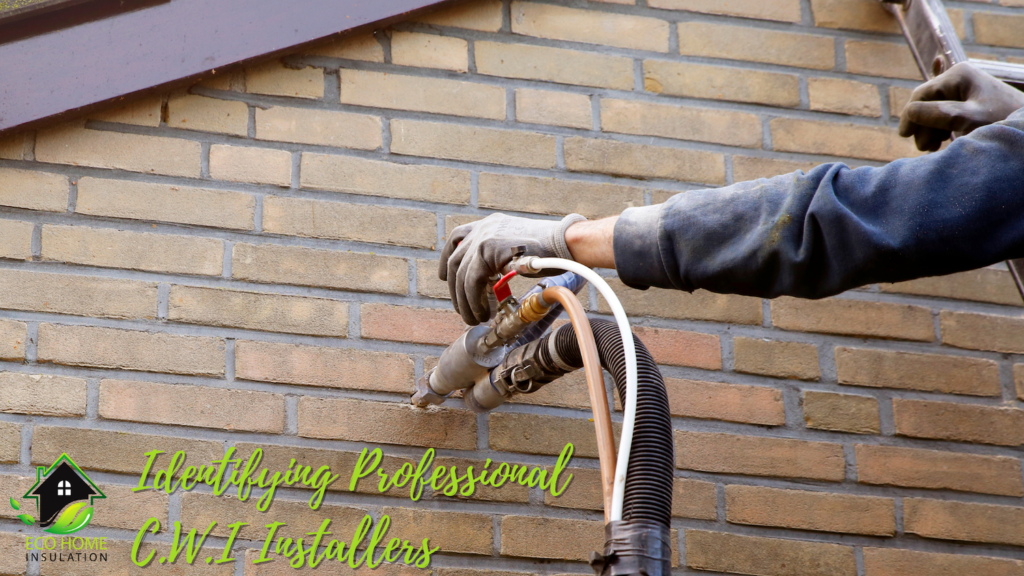Cavity Wall Insulation is a fantastic way to keep you home warm and costs down however, it is important to find the right installer to get the job done properly. Eco Home Insulation are a fully qualified PAS 2030 standard and gas safe registered company working in compliance with British Building Standards. Our company delivers grant funded measures to a wide customer base via an expansive range of energy efficient methods to directly reduce your energy bills and carbon footprint.
Our role involves checking your eligibility for funding, sending our trusted surveyors out to your home to see what measures are required, accessing the funding from the Government for these measures on your behalf, installing the necessary products and helping with any maintenance needed after.
Cavity Wall Insulation
There are many different types of insulation that are used within construction. Depending on the type, location and age of your property different methods will be applied, which are all predetermined by a surveyor. The Energy Companies Obligation (ECO) scheme incorporates 3 main types of insulation within its funding including loft, cavity wall and internal wall.
Most homes that were developed between 1920 – 1990 will have a gap between the internal and external walls of the property, known as a ‘cavity’. When this gap is filled with an insulating material, it ensures that the house is well insulated, meaning the warm air is kept in and the cold air is kept out.
Cavity wall insulation also reduces the speed at which warm air can escape from your property and in doing so means you won’t need to heat your home as regularly – saving you money! The Energy Saving Trust (EST) states that having your cavity walls insulated as opposed to uninsulated, can save you more than £280 per year on your heating costs.
However, not all homes are suitable for this type of insulation. Timber framed, metal clad, and stone properties do not typically require this type of insulation due to their lack of ‘cavity’ within the walls. It is also noted that if the walls within your home suffer from ‘cold wall syndrome’ [damp or cold walls within the interior of your home] then this issue will need to be addressed before the cavity wall insulation is installed. The external wall of your property needs to be in good order before we start this process, and we will of course advise should there be any issues impending the install.
How does it work?
If your property is deemed to be conventionally constructed (most properties post, but not limited to, 1920’s onwards) it is likely to have a cavity (gap/void) between the external and internal walls.
We use the Therma-bead system, which consists of the polystyrene beads being injected into the cavity wall via our unique injection gun into a small hole in either the external or internal skin of the property. As the beads are pumped in, they are mixed with a binding agent forming a homogenous mass that fills the cavity void in its entirety, resulting in a protective barrier that gives permanent reduction in the heat loss to your home.
All cavity wall insulation installs will benefit from a retrofit assessment, along with additional checks being sent to a chartered surveyor first – who will assess the property type prior to install. This pre-check takes things like the property construction, wall thickness and property location into consideration.
There are many factors which can affect the viability of cavity wall insulation and the insulation will not be installed unless the property meets all the necessary requirements. Upon completion, you will be issued with a 25 year, independent backed, quality assurance guarantee. If we were to ever cease trading, your guarantee will still be in effect.
Is Cavity Wall Insulation the best option for my home?
Before looking into having Cavity Wall Insulation installed to your home, you first need to identify whether it is the right option for you. C.W.I is best suited to properties that have an uninsulated cavity between the internal and external walls. However, if your home has C.W.I within the walls it is worth checking to see if you have an existing guarantee and that the current insulation is of a sufficient standard. If this C.W.I isn’t sufficient then you may want to consider Cavity Wall Extraction and Installation.
If you are unsure of how to check any existing C.W.I or do not know whether your property benefits from C.W.I it may be worth asking a trusted fitter to come and survey your property who will; be able to advise you on the best options.
We at Eco Home Insulation are UK registered and experienced installers of Cavity Wall Insulation.
How much does Cavity Wall Insulation cost?
The cost of Cavity Wall Insulation will typically vary from home to home, depending on the size and age of the property and the type of insulation used. However, The Energy Saving Trust states that regardless of your home type, you should recover the costs of installation within 5 years or less due to the money saved on your energy bills.
Below is a table displaying the estimated average costs of installation, how much you could save on your energy bills and how many kilograms of CO2 emission you could save per annum with C.W.I:

How long will the installation take?
Cavity Wall Installation can typically be installed within a day, and you can expect the process to be fairly quick and hassle free. You are not required to leave your home whilst the installation is completed as most of the work constructed is outside of the property.
However, there can always be complications with any construction so please bare this in mind.
6 things you need to know before applying for loft insulation?
With the recent cost of living crisis meaning energy bills and other household outgoings are on the rise, people across the UK are looking for ways in which to save money. The Eco Scheme is a great way to do this but can be slightly confusing. So, we’ve put a short list together of things you need to know before applying:
- What is the grant? The loft insulation grant is a part of the Eco Scheme. The ECO Scheme has been set up by Ofgem, is overseen by the Government and involves multiple energy companies with the aim to help to cut carbon emissions and reduce fuel poverty within the UK. The grants are available to eligible customers and include CWI, IWI, RIRI, Loft Insulation, Solar, Electric Storage Heaters, Boilers, and Air Source Heat pumps.
- Who can apply? The scheme has been set up to help people in low-income, fuel poor or vulnerable households across the UK. There has been recent changes to the qualifying benefits due to the introduction of ECO4 but the full list of eligibility criteria can be found https://www.ecohomeinsulation.co.uk/ However, there are ways to receive the grant if you do not receive these benefits via the FLEX scheme (offered through some councils).
- How to apply? To check if you qualify for these grants, just fill out our 2-minute eligibility checker on our website and a member of the team will be in touch with you regarding your application.
- What happens when you’re awarded the grant? Once you have completed our eligibility checker, a member of the team will be in touch with you regarding whether the property is eligible for a grant. We will then arrange a time with yourselves to send a surveyor round to your home to assess what measures are needed. If you then decide to proceed the installer will gather the appropriate documentation, meaning you may need to provide evidence such as land registry, benefits, or proof of address. After that some comprehensive checks are done to ensure the installation is completed correctly, safely and to a high standard.
- Benefits of receiving the grant – There are many benefits of receiving the loft insulation grant, including saving money on your energy bills, adding value to your home, and reducing your carbon footprint. The grant means payment isn’t required from yourself, meaning it is a sound investment for the future of your home.
- When will you know when your application is successful? If your application is successful, you will be notified by a member of our team within a few weeks of application. However, if you are unsuccessful a member of the team will also call you to explain why and what steps you could potentially take next.
How can we help?
We would love to help you save money on your energy bills and improve your quality of living within your home, as well as our team having a passion for the environment and lowering the UK’s carbon footprint.
There are many factors to consider before fitting any insulation to your home, which is why at Eco Home Insulation we send our trusted surveyors out to your home before any measures are installed. We will advise on the best measures for your home and talk you through the process before any installation begins.
Providing your home has little damp or condensation and has easy access, it should be easy to insulate. We will check if you home has any pre-existing cavity wall insulation that needs extracting before proceeding with the installation before fitting new Thermabead C.W.I to your home.
Our role involves checking your eligibility for funding, sending our trusted surveyors out to your home to see what measures are required, accessing the funding from the Government for these measures on your behalf, installing the necessary products and helping with any maintenance needed after.
If you have any questions on the types of insulation discussed in this blog or want to know whether you qualify for free insulation installation, please contact us today and one of our team would be happy to talk you through your options and eligibility for free funding.
For any questions or queries on our services or the C.W.I Grant please call 0333 444 1062
Or to check your eligibility follow this link https://www.ecohomeinsulation.co.uk/eligibility/

